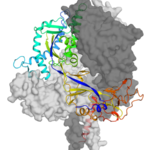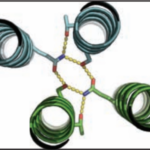Jennifer Doudna, faculty scientist in the Molecular Biophysics & Integrated Bioimaging Division, will share the prize with Emmanuelle Charpentier and Feng Zhang. They were honored “for the development of CRISPR/Cas9 as a breakthrough genome editing platform that promises to revolutionize biomedical research and disease treatment.” The awards, announced over the weekend in Taipei by Nobel laureate Y. T. Lee, each come with a cash prize of $1.24 million, in addition to funds for research. Read more at Berkeley NewsCenter.
Understanding the Key to Henipavirus Infection
In 1994, a virus emerged in Hendra, Australia, causing respiratory and neurological diseases. It was transmissible from horses to humans, with a mortality rate of 57% in humans and 89% in horses. Since then 2 additional deadly species have emerged in Malaysia and Africa, with evidence of 19 more. The members of this Paramyxoviridae family infect host cells through the fusion protein, F, which is embedded in the viral particle membrane. The bulk of the F protein, the ectodomain, protrudes from the membrane’s surface and undergoes a dramatic refolding to merge the virus and host membranes. At the Advanced Light Source (ALS) Beamline 8.2.2 in the Berkeley Center for Structural Biology, researchers used macromolecular crystallography to study the structure of the Hendra F protein ectodomain in its prefusion form and gain insight into its function. Read the ALS Science Brief.
Berkeley Lab Marks LGBT Pride Month
Lesbian, Gay, Bisexual, and Transgender Pride Month is celebrated each year in the month of June to honor the 1969 Stonewall riots in Manhattan. The Stonewall riots were a tipping point for the Gay Liberation Movement in the United States. As part of Pride Month, Berkeley Lab profiled scientists in the Biosciences and Computing Sciences Areas. One of the three to share their stories is Andrew Hagen, a postdoc in Cheryl Kerfeld’s group in the Molecular Biophysics & Integrated Bioimaging Division who was also a former graduate student with Jay Keasling at the Joint BioEnergy Institute. Read his about his experiences, along with those of Deb Agarwal and Elijah Goodfriend, on the Berkeley Lab Diversity & Inclusion website.
Bioscientists Validate Novel Protein Design Program
Over the course of billions of years, nature has evolved particular molecular structures that form the basis of life, such as those found in nucleic acids and proteins. Using the natural form as a springboard, University of Washington researchers have designed protein homo-oligomers, or identical interacting subunits, which can contain interchangeable hydrogen bonding modules for building different structures or functions. The team of researchers, led by David Baker at the University of Washington, included Jose Henrique Pereira, Banumathi Sankaran, and Peter Zwart of the Molecular Biophysics & Integrated Bioimaging Division (MBIB).
Two Bioscientists Selected for World Economic Forum Honor
Karen Davies, staff scientist in the Molecular Biophysics & Integrated Bioimaging Division, and Jenny Mortimer, Director of Plant Systems Biology at the Joint BioEnergy Institute, are two of 50 extraordinary scientists under the age of 40 who have been selected to participate alongside business and political leaders in the World Economic Forum’s Annual Meeting of the New Champions, which is taking place from June 26-28 in Tianjin, China.
- « Previous Page
- 1
- …
- 66
- 67
- 68
- 69
- 70
- …
- 78
- Next Page »
Was this page useful?








